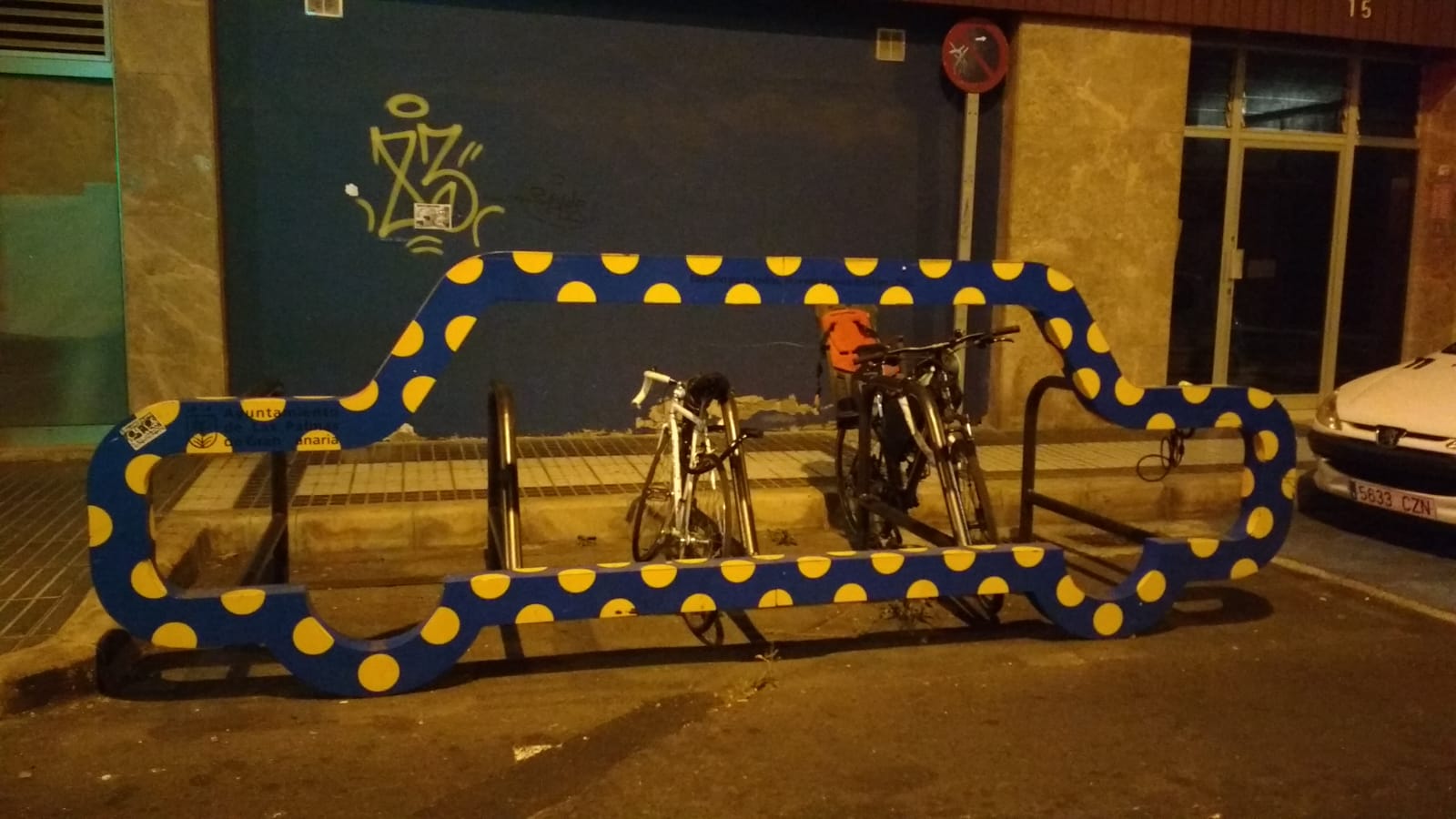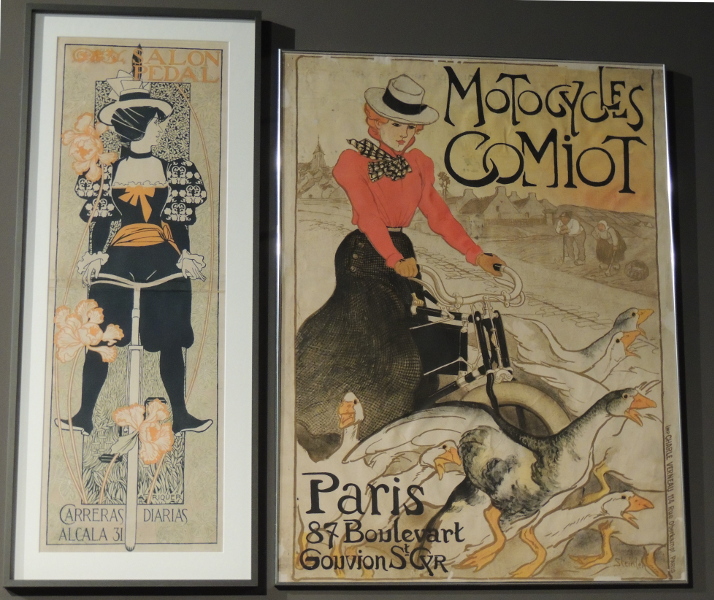Category Archives: Biking movement
How many bicycles take up a car park?
Let’s consider a standard car park, just one of the usually seen in every city. Let’s take into account conventional bikes instead of monster or folding bikes. Sum up inverted U bike racks. And finally, let’s think about putting them perpendicular to the direction a car is parked. As a result of all them, the impressive figure of ten bicycles can be parked in the same surface one car needs to be parked, not considering a two or three floors bike rack, and do considering there is enough space to park and lock each bicycle. If you add a nice, colorful frame, you get this picture:
A solar bike
Riding a bike is considered as environmentally efficient because energy is produced by the pedals movement. If an electric bicycle is used, then part of it is provided by a normally external battery in order to reduce the effort that cyclists make. Going a step further, the solar bikes highlight since the solar light propels them. But how can I build a solar bike?
There are several ways of doing it. For instance, the solar bike based on a bicycle trailer. Here you need:
-
The proper trailer
-
At least one solar panel
-
One external battery
-
One electrical transformer
-
Wires
-
Of course, a bike
-
Gadgets
In a few words, the electrical installation starts with the solar panel which collects energy from the sun and a wire brings it to the battery. The battery stocks up the energy. Next, energy from the battery goes through another wire to the electrical transformer. The electrical transformer allows to use it. At the exit of this gadget the third wire allows electricity to reach the gadgets we want. It is advisable to secure all the elements with bridles or a horizontal surface like the picture. Also, take into account the extra weight of the whole installation.
By the way, if want to know what is the Zima project, check this web: https://www.zimaproject.org/en/home/
Two people on a bike?
The bike movement is unstoppable and several factors promote it. We have the concern about the environment, the health promotion, the personal economy, the interest in living better and longer, the need to learn new issues regarding bikes, the attitude to develop relationships or the desire to make a better world. The positive impacts of riding a bike are impressive, although some people oppose them. Special attention is put on the car industry which has been making everything to stop bikes, from aggressive advertisements in order to discredit these vehicles to brainwashing other people and showing cars like a status symbol. Nothing further from the truth. Negative impacts of cars overwhelm positive ones.
Moreover, some politicians bent on putting a spoke in bike’s wheel since they dictate laws in some cases against logic. Take for example the Spanish law. At the time I am writing this post, one can read some points in it which would have been alright in the past century. One of them is the prohibition of carrying more than two people on a bike given that the second person uses a seat. Spain can look a lot of examples of countries which permit riding bicycles with more than two people on them. If only politicians treasure how cyclists go in central and north Europe. This way they would realize the present law is cochista and more suitable of the past century. But let’s think about the benefits of implementing such a law. Nowadays, some Spanish parents drive their children by car until school to distances up to 3 km generating traffic problems like double parking and increasing pollution in the nearness of education centers. Allowing riding bikes by more than two people would make more parents use it and the reduction of the car use.
Bike and genre
Bicycles can be enjoyed by both, women and men. Nevertheless, the way both genres behave when riding use to be different. Studies say women tend to ride at lower speed without competing between them (at least at no professional level) and appreciate much more landscapes in routes, whereas men tend to be more competitive with more testosterone, ride at higher speed and do not put so much attention to sceneries.
At psychological level, women do not usually speak openly to men regarding common problems they face when biking. On the contrary, they feel more confident to talk about their issues to other women. Moreover, car drivers act differently in arguments with a bike ridden by a woman or a man. If a woman is biking and a dispute with a male car drive takes place, the car driver acts as a beast feeling he has the right to yield or insult the woman even if he is wrong and malicious in his reasoning (supposing he has one since sometimes he has nothing to clutch at straws). In contrast, if a man rides the bike, the male car driver does not show himself so aggressively as he innerly know he could loss in a fight. This animal behavior is another example of the patriarchal society we suffer.
Here I have exposed some reasons because women need women-gender spaces to share ideas and empower themselves. Feminism is a global movement which looks for women to have the same rights as men. Biking is just another field in which come out. As a result of it, changes have been producing. For example, the Iberian Congress was initially opened to both genres, but in the Zaragoza edition they decided to give a space only to women with the creation of the Cyclist Women Meeting. This meeting was repeated in the Valencia edition and it was agreed to differentiate it with an appropriate event by women to women. The Iberian Congress is not expected to count with the Cyclist Women Meeting anymore, which will be an independent event held in a different place and date.
Ciclointegración
Ciclointegración is the invented Spanish word for the integration of determined ways of transport. In a few words, it means that the weak and sustainable vehicles should be integrated into roads. By this I am referring to bicycles, skates, skateboards, scooters, etc. People who drive these should be treated as drivers since they drive vehicles and thus they should move on roads instead of sidewalks. Sidewalks should only belong to pedestrians.
Compare this idea with what is happening now. The vehicles I am talking about enjoy particular areas or lines sometimes stolen to walkers. So pedestrians feel city surface belonging to them is less and less. And do not forget, we all are pedestrian at first and then drivers. So pedestrian areas should be respected above all. Furthermore, potential crashes are avoided with ciclointegración for example between bicycles and people walking on sidewalks who are looking their mobiles or blind people.
Integration means do not create ghettos for green, cycle vehicles, better integrate them into roads. Moreover, thanks to this integration traffic is calmed as they move slower compared to cars and motorbikes. In turn, quality of life is increased, pollution is reduced and, in the long run, some intelligent people would probably stop driving cars because they would realize cars are not worth it.
Criticona 2019
Criticona is the annual Critical Mass in Spain. This huge event moves from city to city thanks to the democratic choice made by the participants in the previous year. It is coordinated by cyclists to riders. Urban cycling is motivated through different activities which are adapted to the organizing place. The organization offers free accommodation and cheap food to make it easy for visitors. Hence, the key target constitutes forming a gigantic Critical Mass since it is the country Critical Mass from the cities Critical Masses.
This year the Criticona will take place in Madrid. A fantastic group of bikers has been working on it for months. The programming can be consulted in the organization official blog (in Spanish). Basically, it starts on 25th April and ends on 28th April. The events per day are specified:
– 25th: Non-mixed riding (riding only for women) + The monthly Madrid Critical Mass
– 26th: Cyclist women experiences discussion + Bike-tapas
– 27th: Meloncleta + Picnic + Event to claim for intermodality + Interplanetary Critical Mass + Party
– 28th: Non-mixed riding (riding only for women) + Historic riding + Picnic
It is highly advisable that you fill the official form if you come from a place other than Madrid.
You can not miss it!
The Bike Equity Network
As in many countries, the USA has a lot of groups which enjoy the bicycle. Among them, there is the Bike League. Its main aim is to “make bicycling safe and comfortable for people of all ages in all communities” with special stress on youth, women and people of color who are underrepresented in many bike efforts and local transportation decisions. And they are right! In too many cases politicians do not take into account the more vulnerable people. If laws are focused on healthy, white, middle age men, they leave other people unprotected. Moreover, the sum of youth, women and people of color (plus senior citizens) makes the majority of USA population. To fulfill this target, they count with an Equity Advisory Council since 2013.
The more people ride bikes, the better the life for everyone. They also establish to strength communities and make them safer and better connected. Cars do not fit in this concepts melting pot and people are in the center. As they affirm, they see bike advocacy as a civic engagement opportunity, and all ways of experiencing biking and streets matter.
History says the League was founded as the League of America Wheelmen back in 1880. Wheelmen were challenged by rutted roads of gravel and dirt and faced antagonism from horsemen, wagon drivers and pedestrians at that time.
They count with key programs such as Bicycle friendly America, Smart cycling, Promoting bicycling or Making biking better throughout which they develop most of its activities.




